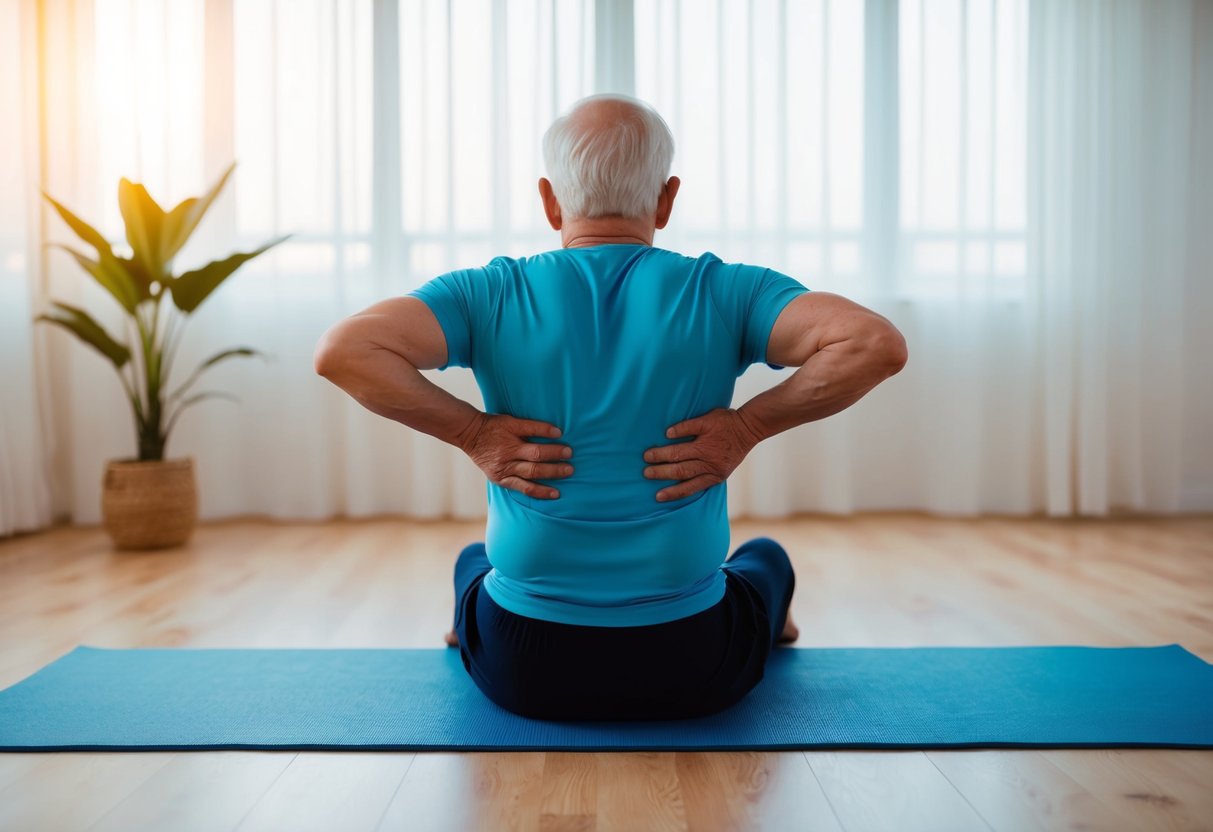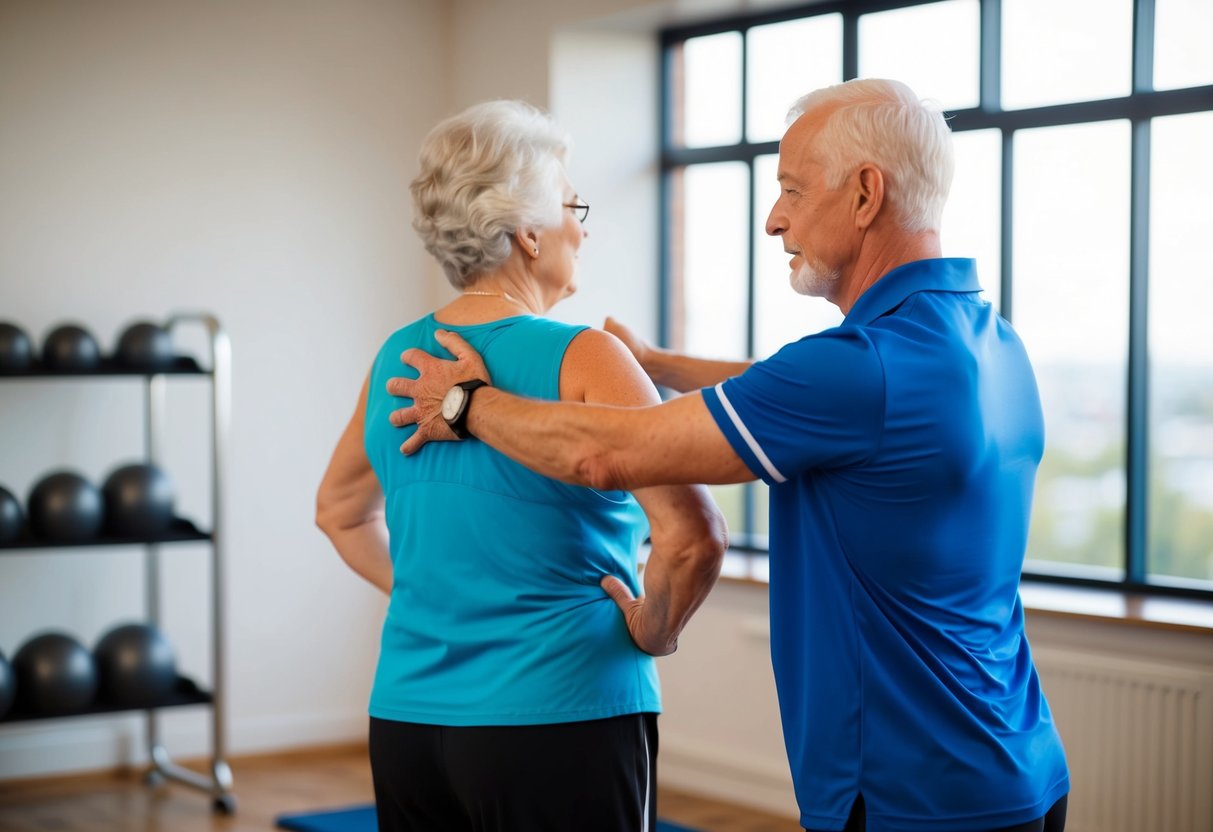Looking for a simple and natural way to ease back pain? Isometric exercises might be just the thing! These gentle movements involve holding a position without moving, making them perfect for seniors looking to strengthen their muscles and reduce discomfort without putting too much strain on the body. Plus, they’re easy to do from the comfort of your own home! Let’s dive into how these exercises can help keep your back feeling strong and pain-free.
Isometric Exercises for Seniors to Reduce Back Pain: Easy and Effective Relief
Back pain can be a real bother as we get older. But there’s good news! Isometric exercises can help seniors ease their discomfort and get back to enjoying life. These simple moves don’t require any fancy equipment or gym memberships.

Isometric exercises for back pain reduce discomfort and help seniors recover more quickly. They involve holding a position without moving, which can strengthen muscles and improve balance. You can do many of these exercises right at home, making them perfect for older adults who want to stay active.
Ready to give it a try? We’ll show you some easy isometric exercises that can help your back feel better. You’ll learn how to do them safely and how often to practice. With a bit of effort, you might find yourself feeling stronger and more comfortable in no time.
Key Takeaways
- Isometric exercises can help reduce back pain without needing special equipment
- Regular practice can improve strength, balance, and overall well-being
- Start slowly and listen to your body, adjusting as needed for best results
The Importance of Staying Active in Senior Years
As you age, staying active becomes even more crucial. Regular exercise helps you maintain your health and independence. It can also make daily tasks easier and more enjoyable.

Physical activity offers many benefits for seniors:
- Improved strength and balance
- Better heart health
- Reduced risk of falls
- Enhanced mental well-being
- Increased social connections
Strength training can be especially helpful. It builds muscle and can ease back pain by strengthening your core. You don’t need to do intense workouts to see benefits. Even gentle exercises like walking or swimming can make a big difference. The key is to find activities you enjoy and do them regularly.
Remember, it’s never too late to start. Even if you haven’t exercised much before, you can still gain from being more active now. Start slow and build up over time. Talk to your doctor before beginning any new exercise program. They can help you choose safe activities that fit your needs and abilities.
Understanding Back Pain in Seniors
Back pain is common among older adults. It can make daily tasks hard and lower your quality of life. Knowing what causes back pain and how to treat it can help you stay active and feel better.

Common Causes of Back Pain
As you age, your spine goes through changes. These changes can lead to back pain. Weak core muscles are a big cause of back issues in seniors. When your core is weak, your back has to work harder.
Other common causes include:
- Arthritis
- Spinal stenosis (narrowing of the spine)
- Osteoporosis
- Disc problems
- Poor posture
Being overweight or not moving enough can also hurt your back. Some health issues like diabetes may increase your risk of back pain too.
How Isometric Exercises Can Help
Isometric exercises can be great for easing back pain. These are exercises where you hold a position without moving. They help build strength and stability in your back and core.
Benefits of isometric exercises for back pain:
- Low low-impact, so they’re easy on your joints
- Can do them anywhere, no special equipment is needed
- Help improve posture
- Increase muscle endurance
Isometric exercises like wall sits or planks can strengthen your back muscles. This takes the pressure off your spine. Doing these exercises regularly can help you move better and feel less pain.
Getting Started with Isometric Exercises
Isometric exercises can help seniors reduce back pain and improve strength. These simple moves are easy to learn and can be done almost anywhere.
Safety Tips Before Beginning
Before starting any new exercise routine, talk to your doctor. This is especially important if you have health issues or injuries. Make sure you’re wearing comfy clothes that let you move freely. Start slow and listen to your body. If something hurts, stop right away. It’s normal to feel some muscle tension, but sharp pain is a warning sign.
Keep breathing steadily during each exercise. Holding your breath can raise blood pressure. Count to 5 as you breathe in and out. Stay hydrated by drinking water before, during, and after your workout. This helps your muscles work better and prevents dizziness.
Assessing Your Current Fitness Level
Know where you’re starting from to set realistic goals. Try holding a wall sit for as long as you can. Write down how long you lasted. Test your grip strength by squeezing a soft ball. Note how long you can hold it firmly.
Check your balance by standing on one foot. Time how long you can hold the pose without wobbling. Do these tests once a week to track your progress. You’ll likely see improvements over time. Remember, everyone starts at a different level. Don’t compare yourself to others. Focus on your own journey and celebrate small wins along the way.
Isometric Exercises for Back Pain Relief
Isometric exercises can help seniors reduce back pain without putting too much strain on their bodies. These exercises involve holding static positions to build strength and stability in key muscle groups.
Wall Presses
Wall presses are a great way to strengthen your back muscles. Stand with your back against a wall, feet about 12 inches away. Press your lower back firmly into the wall and hold for 10-15 seconds. Relax and repeat 5-10 times.
This exercise helps improve posture and reduces strain on your lower back. You can adjust the difficulty by moving your feet closer or farther from the wall. Remember to breathe normally during the hold. If you feel any pain, stop the exercise and consult your doctor or physical therapist.
Chair Squeezes
Chair squeezes are effective for reducing lower back pain. Sit in a chair with your feet flat on the floor. Place a small pillow or rolled-up towel between your knees.
Squeeze the pillow with your knees and hold for 5-10 seconds. Release and repeat 10-15 times. This exercise strengthens your inner thigh and pelvic muscles, which support your lower back. Try to keep your upper body relaxed while doing this exercise. You can do chair squeezes several times a day to build strength gradually.
Pelvic Tilts

Pelvic tilts help improve core strength and flexibility. Lie on your back with your knees bent and feet flat on the floor. Tighten your abdominal muscles and press your lower back into the floor.
Hold this position for 5-10 seconds, then relax. Repeat 10-15 times. This exercise can help relieve lower back pain and improve your posture. Start with shorter hold times and gradually increase as you get stronger. Make sure to keep your movements slow and controlled.
Abdominal Bracing
Abdominal bracing is a simple yet powerful exercise for back pain relief. Lie on your back with your knees bent and feet flat. Tighten your abdominal muscles as if you’re preparing for someone to punch your stomach.
Hold this contraction for 5-10 seconds, then relax. Repeat 10-15 times. This exercise strengthens your core muscles, which support your spine and help reduce back pain. You can also do this exercise while sitting or standing. Practice abdominal bracing throughout the day to improve your core strength and stability.
Progressing with Isometric Training
As you get stronger, you can make your isometric exercises more challenging. There are two main ways to do this: holding positions longer and doing more repetitions.
Increasing Hold Times
Start by holding each position for 5-10 seconds. As this gets easier, try to hold for 15-20 seconds. Then gradually work up to 30-second holds. Remember to breathe normally while holding. Don’t strain or hold your breath. If you feel pain, stop and rest.
For back exercises, like wall sits or planks, aim to add 5 seconds each week. Use a timer to track your progress. Always listen to your body. It’s better to do shorter holds with good form than longer holds with poor form.
Adding More Repetitions
Begin with 1-2 reps of each exercise. As you get stronger, add more reps. Try to work up to 5-8 reps per exercise. Take short breaks between reps. Start with 30-second rests and shorten them as you improve.
You can also try doing your exercises more often. Start with 2-3 times a week. Gradually increase to 4-5 times if you feel comfortable. Isometric exercises for seniors are gentle on your joints. This means you can do them more often without risking injury.
Remember to balance your routine. Include exercises for your upper back, lower back, and core muscles.
Incorporating Other Exercise Forms
Adding different types of exercises to your routine can help reduce back pain and improve overall fitness. A mix of stretching, balance work, and low-impact cardio can support your isometric exercises.
The Role of Stretching
Stretching is key for keeping your muscles flexible and reducing back pain. Try these simple stretches:
- Gentle back twists
- Knee-to-chest pulls
- Cat-cow pose
Hold each stretch for 15-30 seconds. Do them daily, especially before and after other exercises. Stretching can help ease back pain and improve your range of motion. Remember to breathe deeply and move slowly. Don’t push yourself too hard. If you feel pain, stop the stretch right away.
Balance and Stability Workouts
Working on your balance can help prevent falls and support your back. Try these exercises:
- Single-leg stands
- Heel-to-toe walks
- Sit-to-stand practice
Start with 30 seconds for each exercise. As you get stronger, try to hold them longer. Always have a chair or wall nearby for support. Balance exercises strengthen your core muscles. This helps take pressure off your back. Do these workouts 2-3 times a week for the best results.
Low-Impact Aerobic Activities
Aerobic exercise is great for your heart and can help manage back pain. Choose low-impact options like:
- Swimming
- Walking
- Stationary biking
Aim for 30 minutes of activity, 5 days a week. Start slow and build up over time. These exercises can improve blood flow to your back muscles. Walking is easy to do and doesn’t need special equipment. Swimming is excellent for seniors as it’s easy on your joints. Pick activities you enjoy to stay motivated.
Maintaining a Routine
Keeping up with your isometric exercises is key to reducing back pain. A good routine helps you stay on track and see real results. Let’s look at how to make a plan that works for you.
Creating a Sustainable Schedule
Choose workout times that fit seamlessly into your daily routine—whether it’s right after breakfast or just before bed. Start with manageable sessions, like 10 minutes, three times a week, and gradually increase the time or frequency as you get stronger.
Always pay attention to how your body feels, and give yourself a break if you’re sore. To help make exercise a habit, try pairing it with activities you already do, like holding a wall sit while brushing your teeth. Keeping track of your workouts, even with something as simple as marking your calendar, can be incredibly motivating as you watch your progress grow!
Setting Realistic Goals
Start small and gradually build up your routine. For example, your initial goal could be to do isometric exercises for 5 minutes every other day. As this becomes easier, set new, more challenging goals. Be specific with your targets—rather than aiming to “reduce back pain,” try something like “hold a plank for 30 seconds by next month.”
Keep track of how you feel along the way, noting improvements like less back pain or an increase in daily activities—these are significant milestones! Be patient with yourself, as progress takes time, and celebrate every small victory. If you miss a day, don’t get discouraged. Simply get back on track the following day, remembering that consistency over time is what truly matters.
Nutrition and Hydration
Good food and drink choices can help ease back pain and support your exercise routine. Eating well and staying hydrated will give you more energy and help your muscles recover faster.
Best Foods for Muscle and Bone Health
Calcium-rich foods are great for your bones. Try to eat more dairy products like yogurt, cheese, and milk. If you don’t like dairy, try leafy greens like kale or spinach. They’re packed with calcium too. Protein is key for building strong muscles. Lean meats, fish, eggs, and beans are all good choices. Aim to have some protein at every meal.
Omega-3 fatty acids can help reduce inflammation in your back. You can find these in fatty fish like salmon or in walnuts and flaxseeds. Vitamin D helps your body absorb calcium. You can get it from sunlight, but foods like egg yolks and fortified cereals are good sources too.
Importance of Hydration
Water is crucial for your body, especially when you’re doing exercises. It helps keep your joints lubricated and your muscles working well. Try to drink water throughout the day. Don’t wait until you feel thirsty. By then, you might already be a bit dehydrated.
If you don’t like plain water, try adding a slice of lemon or cucumber for flavor. Herbal teas are another good option. Remember, some foods like watermelon and cucumbers have high water content. These can help you stay hydrated too. Avoid drinks with caffeine or alcohol. They can make you lose more water and might interfere with your sleep.

Monitoring Progress and Adjusting When Necessary
Keeping track of your isometric exercise routine is key to seeing results. You can use a simple notebook or a fitness app to log your workouts. Write down the exercises you do, how long you hold each position, and how many times you repeat them. This helps you see your progress over time.
Pay attention to how you feel after each session. Are you less sore? Can you hold positions longer? These are good signs that you’re getting stronger. If you’re not seeing improvements after a few weeks, it might be time to adjust your routine. You could:
- Increase the time you hold each position
- Add more repetitions
- Try new isometric exercises
Remember, listen to your body. If an exercise hurts, stop doing it and talk to your doctor or a fitness expert. Don’t push yourself too hard. Small, steady progress is better than risking injury by doing too much too soon. Celebrate your wins, no matter how small. Maybe you can now hold a wall sit for 10 seconds longer, or your back feels less stiff in the morning. These are all signs that your hard work is paying off!
When to Seek Professional Advice

You should talk to a doctor before starting any new exercise program. This is especially true if you’re over 65 or have health issues. Call your doctor right away if you feel sharp pain during isometric exercises. Sudden or severe back pain needs quick medical attention.
Watch out for these warning signs:
- Numbness or tingling in your legs
- Weakness in your arms or legs
- Loss of bladder or bowel control
- Fever with back pain
This could mean something serious is wrong. Don’t ignore them. Your doctor might suggest seeing a physical therapist. They can teach you safe ways to do isometric exercises. They’ll make sure you’re doing them right to avoid injury.
Remember, some discomfort is normal when you start exercising. But pain that gets worse or doesn’t go away isn’t okay. Listen to your body. If something feels off, stop and ask for help. Regular check-ups are a good idea. Your doctor can keep track of your progress and adjust your exercise plan if needed. Don’t be shy about asking questions. Your health team is there to help you stay active and pain-free.
Fun Fact
Did you know that isometric exercises not only help with back pain but also offer a great stress relief bonus? When you hold these poses, they naturally encourage deep, steady breathing, which activates your body’s relaxation response. This helps lower cortisol levels, reducing stress and promoting a sense of calm. As you focus on maintaining the position and breathing deeply, your mind shifts away from daily worries, making you feel more centered and relaxed overall. It’s a simple way to strengthen your body and de-stress at the same time!
Isometric Exercises: A Senior’s Guide to Back Pain Relief
Isometric exercises provide a straightforward, natural way for seniors to ease back pain while boosting overall strength. These gentle, low-impact exercises are perfect for home practice, requiring no equipment, and can easily be adapted to suit any fitness level.
By holding specific positions and incorporating deep, focused breathing, you engage the muscles that support your spine, helping to relieve discomfort. Plus, the calming effect of deep breathing adds an extra layer of stress relief. With regular practice and patience, isometric exercises can keep you active, pain-free, and more relaxed than ever!
Ready to alleviate back pain naturally? Share your experiences with isometric exercises and inspire others to improve their well-being.
Frequently Asked Questions
Isometric exercises can be helpful for seniors dealing with back pain. These exercises are safe, and effective, and can be done almost anywhere. Let’s explore some common questions about isometric exercises for seniors.
What are the best isometric exercises for seniors to alleviate back pain?
The wall sit and bridge exercises are great for seniors with back pain. Wall sits strengthen your lower back and legs. Bridge exercises target your glutes and lower back muscles. You can also try single-arm isometric rows. These work your upper back and can be done using a flat bench or sturdy table.
Can seniors safely perform isometric exercises to manage back discomfort?
Yes, isometric exercises are generally safe for seniors. They put less stress on your joints compared to other types of exercise. Start slowly and listen to your body. If you feel pain, stop the exercise. It’s always a good idea to talk to your doctor before starting a new exercise routine.
What isometric exercises can help improve back strength for people over 60?
Planks and side planks are excellent for building core and back strength. These exercises work for multiple muscle groups at once. You can also try isometric back extensions. Lie on your stomach and lift your upper body, holding the position for a few seconds.
How often should seniors perform isometric exercises to reduce back pain?
Aim to do isometric exercises 2-3 times a week. Start with short holds of 5-10 seconds and gradually increase to 20-30 seconds as you get stronger. Remember to give your muscles time to rest between sessions. This helps prevent injury and allows for proper recovery.
Are there seated isometric exercises suitable for seniors with limited mobility?
Yes, there are several seated isometric exercises you can try. Seated leg lifts work your lower back and core muscles. You can also do seated back presses. Sit straight and press your back against the chair, holding for a few seconds.
What precautions should seniors take when engaging in isometric exercises for back pain?
Always warm up before exercising. This helps prepare your muscles and reduces the risk of injury. Start with gentle exercises and short hold times. Then, gradually increase the intensity as you get stronger.
Don’t hold your breath during exercises. Make sure to breathe normally to ensure proper oxygen flow to your muscles. If you experience sharp pain, stop the exercise immediately. Consult your doctor if the pain persists.
Revitalize Your Fitness Journey After 55!
Keeping active not only strengthens your body but also boosts your immune system! Head over to our website, Fit After 55, for inspiring content, product reviews, and a supportive community focused on fitness for all ages. Don’t forget to connect with us on Facebook: Fit After 55 Facebook. Let’s get moving together!

